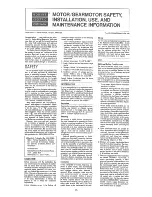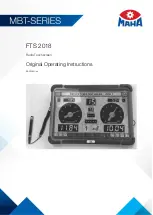
- 2 -
PB200-2
OPERATION
GENERAL
This PolyBlend unit will perform the following
functions: meter polymer dosage, regulate mixing
water, provide uniform dilution and activation, operate
on-line continuously, and feed solution to the point of
use.
Neat polymer from the metering pump and dilution
water controlled by the solenoid valve enter the mixing
chamber. Dilution and activation occur, yielding
prepared solution ready for use.
Neat polymer dosage rate is adjusted at pump face or at
electronic controller (REM-1E, SCR, etc.). Primary
dilution (and post dilution) water are controlled by
individual flow control valves.
START-UP
Step 1: Switch pump to external mode at pump face.
Step
2: Prime polymer pump, using priming kit
provided with unit.
Step 3: Place unit power switch in Off position.
Step
4:
Energize power circuit that feeds unit.
Solenoid opens. Allow mixing chamber to fill
with water by opening primary dilution water
control valve.
NOTE: Do not turn mixer motor on until
chamber is filled with water, running dry will
damage mechanical seal.
Step 5: Place unit power switch in On position.
Mixing chamber motor starts.
Step
6: Access REM-1E controller to turn pump
On/Off and for polymer output adjustment.
Output can also be adjusted at pump face by
varying the stroke length.
NOTE: For optimum pump performance,
keep stroke frequency as high as possible.
This is done by decreasing the stroke length
setting. More stroke repetition with a shorter
length is better than fewer strokes with a long
stroke length. If stroke length is too short,
pump prime may be affected.
Step
7: Adjust water flow at mixing chamber by
turning control valve. (The other control valve
should be turned for post-dilution adjustment,
if applicable.)
NOTE: Do not run polymer pump unless
water flow is established. Polymer alone can
plug discharge plumbing.
WATER PRESSURE
This unit is equipped with a differential pressure switch.
It has been factory set. See Appendix for details.
SOLUTION OUTPUT
Unit output is determined by setting pump stroke
length and stroke frequency together with setting
dilution water flow. Establish desired solution volume
and solution concentration, then proceed.
EXAMPLE: 100 GPH (380 LPH) of .5% polymer
solution desired. A 2 GPH (7.6 LPH)
diaphragm pump is used.
— Determine neat polymer requirement.
(100 GPH) x (.005) = 0.5 GPH neat polymer
(380 LPH)) x (.005) = 1.9 LPH neat polymer
— Determine pump usage.
(0.5 GPH)
÷
(2 GPH) = 25% pump capacity
(1.9 LPH)
÷
(7.6 LPH) = 25% pump capacity
— Set Controls
A 2 GPH (7.6 LPH) pump @ 100% stroke length and
25 strokes per minute will deliver 0.5 GPH (1.9 LPH).
However, 2 GPH (7.6 LPH) pump @ 50% stroke
length and 50 strokes per minute will also deliver 0.5
GPH (1.9 LPH) with a more homogeneous mix.
NOTE: Do not exceed polymer
concentrations of 1% in the PolyBlend.
Summary of Contents for PolyBlend PB200-2
Page 17: ...15 ...
Page 18: ...16 ...
Page 19: ...17 ...
Page 20: ...18 ...
Page 21: ...19 ...
Page 22: ...20 ...
Page 24: ...200 D 007 ...
Page 26: ...MC 0101 24 ...
Page 28: ...Blank Page 26 ...
Page 30: ...OPD 0001 Post Dilution Static Mixer Assembly P N 5860001 28 ...
Page 32: ...Series AA7 Drive Assembly Exploded View Diagram 30 ...
Page 35: ...33 ...
Page 36: ...34 ...





































